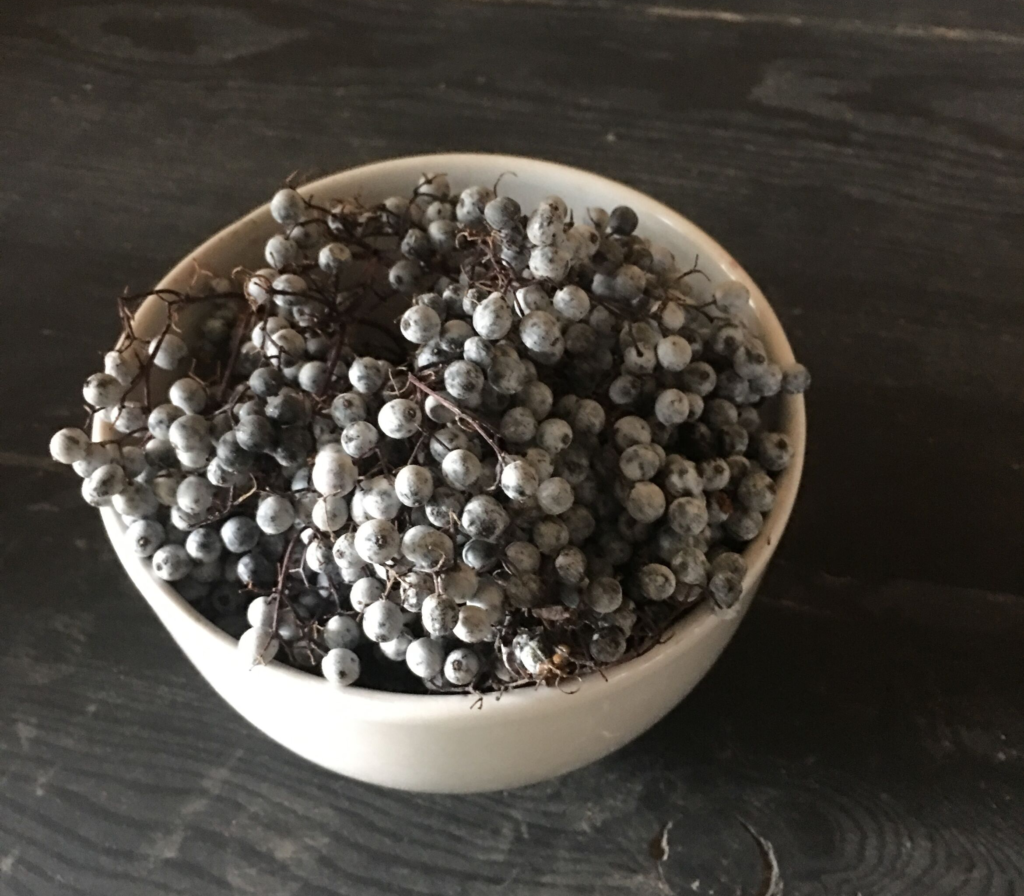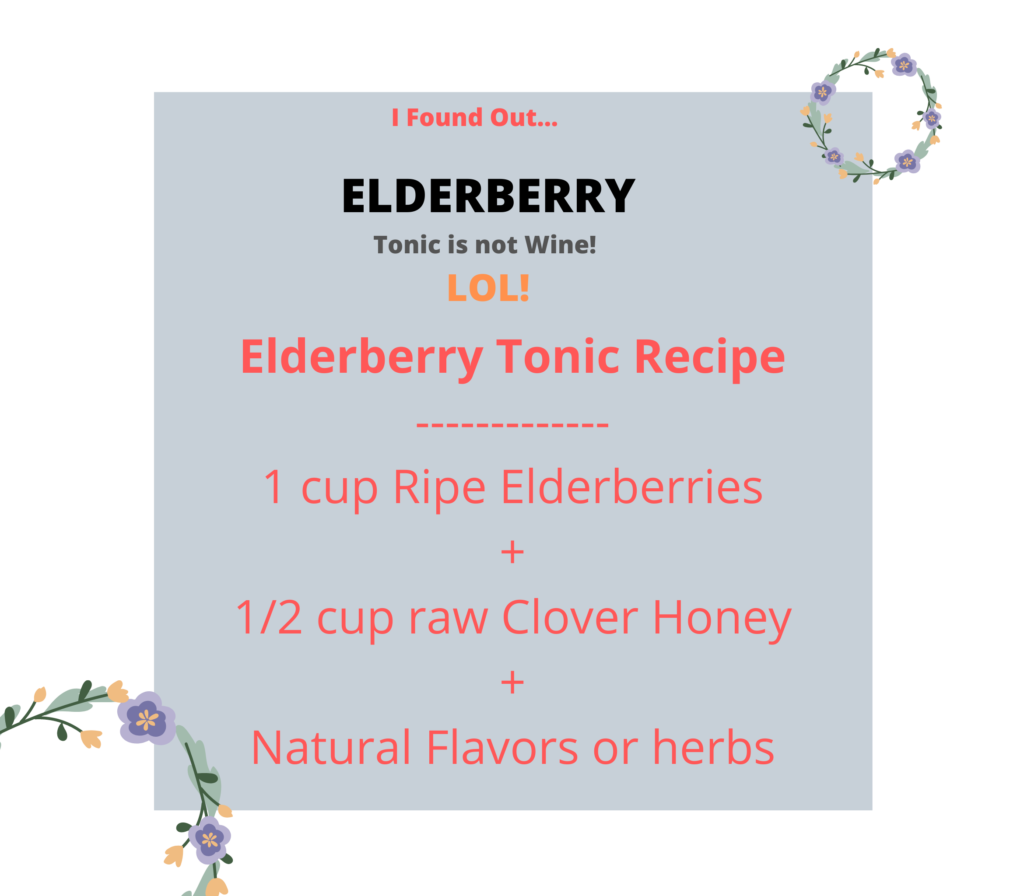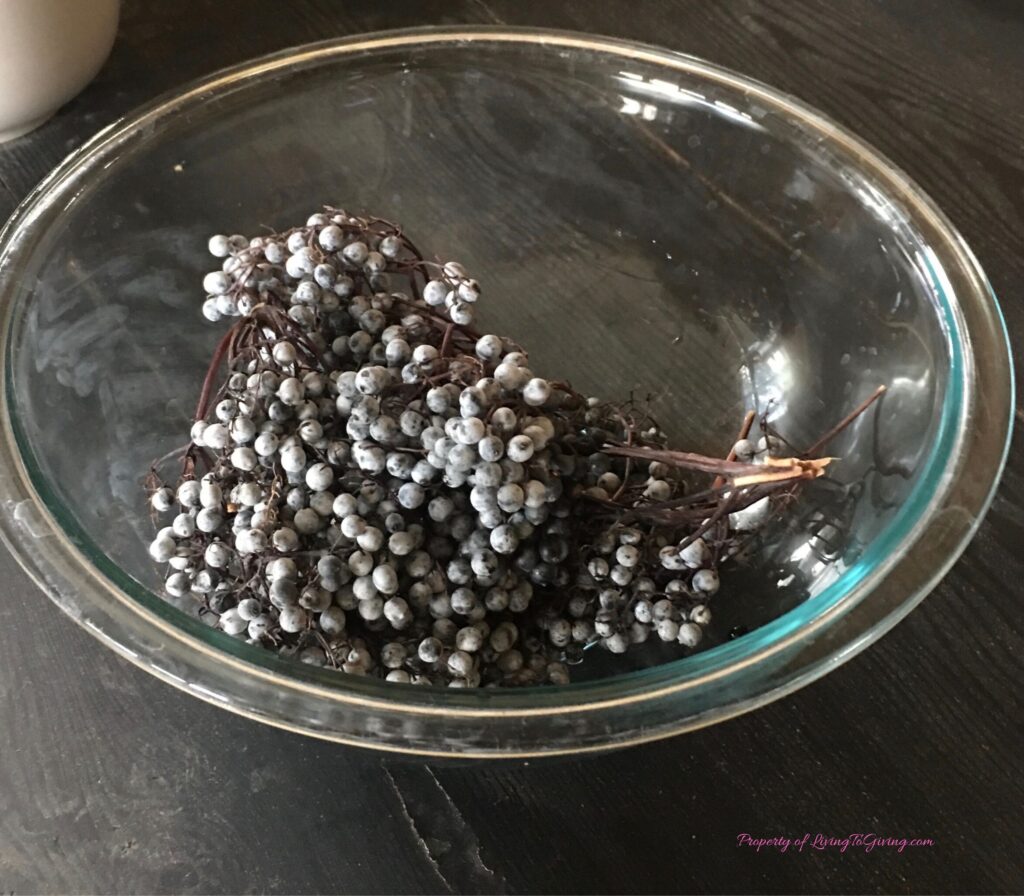7 Basic Facts About Elderberries
Berries Make a Good Tonic
I remember the great times I had with picking fruit from our land. Our neighbors had an orchard of elderberry trees. We had permission to pick from them. They are so easy to pick if you were able to get to them. I usually had the kids climb the trees to pick them. That way we both got a win.

I also remember how they laughed at mom (me) who unknowingly gave them fermented elderberry as a tonic when they were sick. Well, mom has learned much through the years. It tasted quite well, and no one was very much affected by it except their ‘stomachs felt better.’ Great probiotics. Right?

Why do kids make a big deal out of something anyway! We had a lot of fun with that discovery.
I don’t have many pictures of that time in digital form – that was before my iPhone, but each of us have very fond memories. The best memory I have now is the knowledge my children learned from how to eat healthy.
Those adventures are easy to pass down! They are teaching me now. Just like when my mom taught me a love of cooking and my dad made camping fun and available. My kids were passed down these memories.
Great point here! I do not recommend trying to ferment the berries without a good, proven recipe that is safe. I included this story as just a story and not as a recommendation to let the berries ferment unless you understand the correct process.
Elderberries Can Be Propagated
Just like any fruit – make sure they are ripe. Do some research and make sure they are edible. I am not an expert on elderberry, but any elderberry I picked was certainly edible! But I like them ripe! Some red elderberries are not edible, and some red berries may look like other berries that shouldn’t be eaten, so I stayed with the black elderberries (since I have not seen any red elderberries around me).

My son picked these a little green. I am experimenting with planting the seeds. They have to go through a process called stratification, an exposure to winter cold. I realize that these plants may have a variety of characteristics different from each other, but I wanted to try this method.
I do not have a tree that I can get cuttings from. That is the method preferred if you want to get the same characteristics in each elderberry plant.
We were able to dig up an elderberry tree on our property and transplant it successfully also. Elderberry is a go to for everyone in my family now, whenever they get sick!
Elderberries Have an Important Historical Background
But what is special about Elderberries is their history. The name Sambucus Nigra means the color ‘black’ in Latin. The Anglo-Saxon term came from a word meaning ‘fire’. Apparently, the hollow stems of the branches were used as bellows to flame a fire.
These berries have been used as a health remedy for centuries. As early as 1931, elderberry has been documented for traditional medicinal use for reducing the effects of colds and flu, for use as a diaphoretic (to make a person perspire for the purpose of releasing toxins through the sweat) and as a diuretic (increase the releasing of water through the kidneys)
In 1931 it was documented in Europe for use for back pain, nerve pain and dental pain as well as for headaches and heart issues.
Quotes and historical entries to document use
- Maduaus in 1938 noted an entry for use as a diaphoretic (promote sweating):
- “20 g (20 ml) as juice (Succus Sambucci inspissat’) in port wine once daily”.
“Elder Rob. Take of ripe Elder-berries five parts, sugar one part. Boil with a gentle heat to the consistency of a thick honey. This is prescribed as a diaphoretic, in the dose of an ounce and a half to two ounces, in febrile disease, and in acute rheumatic affection; likewise made into a gargle for sore throats.”
Barton B, Castle T, 1837
- In 1788, a documented use of the berry as a laxative to prevent constipation was written:
- “An elderberry syrup called ‘Roob Sambuci’ can be made with 2.27 kg of fresh berries cooked with 453 g of sugar to the thickness of honey. Take in large doses.” British Pharmacopoeia, Grieve in 1931.
Ripe Elderberries Have Important Nutrients
As in most berries, there is an abundance of minerals and vitamins, and antioxidants like Vitamin C and flavonoids. Other nutrients include Vitamin A, C, and E; trace elements like Copper, Zinc and Iron; and minerals such as Potassium, Calcium and Magnesium. A high level of vitamin B is found in the berries also. *
That means that Elderberries are good for heart health, immune system boost, energy and essential cell health. There is evidence that respiratory health (fighting colds and flu), and mental health is affected also. That’s good news!
*Fruit Phenolic Composition of Different Elderberry Species and Hybrids. Mikulic-Petkovsek M, Ivancic A, Todorovic B, Veberic R, Stampar FJ Food Sci. 2015 Oct; 80(10):C2180-90.
Special Nutrients Sustain Winter Health
They are very famous for many healthy nutrients. I always wanted to live on a land that had its own self-sufficient green store! I have it here! When we first came to this property, we had sheep. The kids knew how disappointed I was when I found out that the sheep ate the only elderberry tree we had on the property!
Before I started using Elderberries, my family would normally get the sickness that was around. It terrified me when my young ones became very sick with whooping cough. I did my research and found out that keeping immunities up was a very important part of healing.
Special Uses
We used elderberries almost exclusively whenever we got sick. We used them for:
- Colds and flu
- Sinus problems
- Back and leg pain
- Nerve pain
- Energy
- Hay fever
- To get rid of constipation
- Headaches
- Toothaches
- Sore mouths
- Elderberries are also used for:
- Diseases
- Urinary problems
- To lose weight
- Boosting the immune system
- Soothing baths – from the flowers
- Reducing inflammation
- Reducing blood sugar
- Antibacterial actions
A combination of the extracts of elderberry with other berries (raspberry, cranberry, bilberry and blueberry) has been tested as an anti-bacterial agent against a serious intestinal bacterium, Helicobacter Pylori. *

Identifiers Make the Berries Easy to Find
I have always been interested in survival medicine and learned my own version of it. But when my son became part of the Air Force, I took this information out of a book** he had. This book teaches actual survival techniques and how to use the elderberry as a survival food because of the wealth of nutrients contained in the berry.
- Elderberry bushes or trees are named Sambucus. Sambucus Nigra is a common tree and is found among woods and wild shrubs.
In mid-summer, the black berries on their red stems are easy to spot. I have seen them with other Elderberry trees, or they may be single trees. The leaves are the best way I use to recognize the Elderberry Tree. The leaves have more than 5 leaflets and are serrated. The distinctive round shape of the tree is what catches my eye at first. It can grow from 10 to 25 feet. The flowers have a distinctive creamy white color and are in clusters which will later turn into the distinctive berry clusters. The flowers are also edible.
Source: ** SAS (British Special Air Service) Survival Handbook. How to Survive in the wild, in any climate, on land or at sea. John “Lofty” Wiseman
Start With a Quick Basic Recipe
This is a very simple and easy recipe, use it for hiking or camping times. It is designed to be able to make use of little equipment in a survival situation. **
- Boil all the clean, ripe berries so that they make a syrup, use a little clean water to start.
- I would add a sweetener.
- Store in clean containers.
- Berries can be dried on a sheet away from sun. Let them dry for 10 days, turning them often so they dry quickly and thoroughly. The seeds become crunchy and are not so bothersome to eat when they are dry.
Additional facts about wild berries when you hike or camp.
- The easiest way to harvest the berries is to cut them off the tree in their clusters.
- Any bacteria are killed by boiling.
- Some reddish varieties may not be edible, bring a field guidebook with you if you are not sure what you are looking for.
- Jelly can be made with the cooked down berries that are put through a sieve. Use the juice for jam or jelly, the seeds in the berries are not very tasty.
- The seeds do not need to be removed for jam.
- There is usually enough pectin in the fruit but you can add crab apples or a high pectin fruit to it so it will set up.
- If it is not convenient to preserve the juice, these berries can be eaten fresh (they are very tart). I guess I would eat them with honey unless I was desperate for food.
- Remember they have many, many tiny seeds inside the fresh berry and that ruins the taste for me. (I don’t really cherish trying to spit that many seeds out). Like I said, when they are dry, they are crunchier.
Source: ** SAS (British Special Air Service) Survival Handbook. How to Survive in the wild, in any climate, on land or at sea. John “Lofty” Wiseman
*European Medicines Agency, Science Medicines Health. 28 January 2014 EMA/HMPC/44208/2012 Committee on Herbal Medicinal Products (HMPC) “Assessment report on Sambucus nigra L., fructus” Based on Article 10a of Directive 2001/83/EC as amended (well-established use) Based on Article 16d (1), Article 16f and Article 16h of Directive 2001/83/EC as amended (traditional use)

I love elderberries juice. I did not know they have so many health benefits! Thank you for sharing so interesting information.
Thank you for saying that. In many ways I still am learning about the benefits.
This is a great post. Elderberry syrup is so popular. I really like the various information you shared, like your personal experiences, the history, how to identify, and benefits and uses. This was really fun and informative. Thanks!
That is so kind. I am glad it was fun and informative.
Such a versatile and useful plant! Thank you for sharing!
Thank you for reading. I love using this tree!
Yes! I love Elderberries! I make syrup and take some every day to keep the cold and flu a bay, so far it’s working. I didn’t know it could help with back and leg pain also, what a bonus!
I am so glad you are using Elderberries! I do get some from an organic store at times.
I really enjoyed your blog! We love making our own elderberry syrup, instead of using the store ones. Your blog makes me want to go foraging like literally right now! 🙂 Thank you for all of this useful info!
So much fun this foraging. My son brought me home some and said he wanted to grow some. We were able to grow them from seeds, but it took a few seasons before they came up. That was fun!